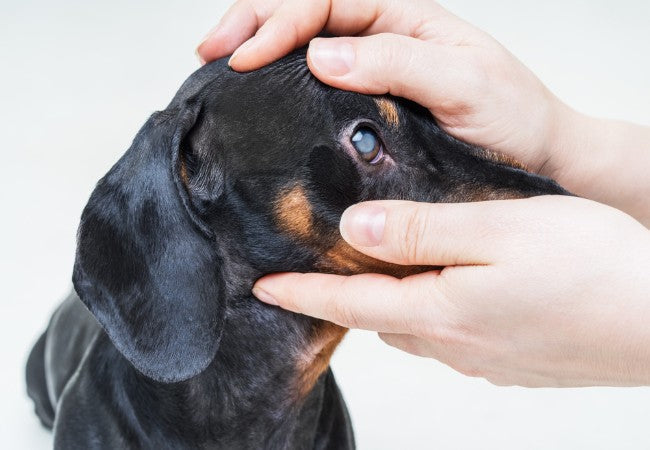Veterinary Guide to Horner’s Syndrome in Dogs 2025 🩺🐶

In this article
Veterinary Guide to Horner’s Syndrome in Dogs 2025 🩺🐶
By Dr. Duncan Houston BVSc
👁️ What Is Horner’s Syndrome?
Horner’s Syndrome arises when the sympathetic nerve pathway to the eye is disrupted. As a result, parasympathetic signals dominate, leading to classic ocular symptoms, but it is not painful or life-threatening itself.
🎯 Key Clinical Signs
- Ptosis (drooping upper eyelid)
- Miosis (constricted pupil)
- Enophthalmos (sunken eye appearance)
- Third eyelid elevation (nictitating membrane visible).
- Also possible: warm/red ear flap or nose, conjunctival redness.
🔁 How It Happens (Sympathetic Pathway Disruption)
The sympathetic nerve fibers begin in the brainstem, travel down the neck, into the chest, then return via the neck alongside the carotid artery to innervate the eye. Interruption anywhere along this path causes Horner’s.
🧬 Common Causes
- Idiopathic: 40–50% of cases—good prognosis, often resolves spontaneously.
- Ear disease: otitis media/interna affecting postganglionic fibers.
- Trauma: head, neck, chest, or jugular venipuncture injuries.
- Neoplasia: tumors in the neck, chest, spine, or brain.
- Neurological disease: IVDD, FCE, cerebrovascular injury.
- Rare causes: diabetes mellitus, vestibular disease, and thoracic surgery trauma.
🐕 Predisposed Dogs & Incidence
Any breed or age can be affected. Golden Retrievers, Labs, Shelties, Collies, Dobermans, and Weimaraners seem more prone. Onset is usually unilateral and sudden.
🩺 Diagnosis Workflow
- History and physical exam noting ≥3 classic signs.
- Eye and ear examination—otoscopy if ear disease suspected.
- Baseline labs—CBC, chemistry, urinalysis to assess overall health.
- Imaging—X-rays of chest/neck, CT/MRI if indicated.
- Pharmacologic localization—phenylephrine drops help pinpoint nerve lesion location.
🛠️ Treatment Approach
Treat the Underlying Cause
- Otitis: antibiotics, ear cleaning, and possible surgery.
- Tumors/spinal disease: surgery, oncology, or neurosurgery referral.
- Trauma: symptomatic care plus imaging and referral.
Symptomatic & Supportive Care
- No specific therapy is typically needed—the eye remains functional.
- Phenylephrine eye drops may reverse ptosis/miosis but are cosmetic.
- Acupuncture may help idiopathic cases—a single case report suggests rapid improvement.
- Prevent further trauma—use harnesses, protect against neck injury.
⌛ Prognosis & Recovery Timeline
- Idiopathic: excellent, often resolves within 8 weeks to 4 months.
- Ear disease: good with appropriate treatment.
- Neuro/tumor/trauma: variable—based on cause; may recover partially or remain permanent.
- Recurrence is rare once resolved.
🏡 Owner Care & Monitoring
- Monitor for resolution or progression via photos and eye exams.
- Report any development of neurological signs immediately.
- Continue performing ear hygiene and checkups.
- Avoid neck trauma—opt for harnesses, not collars.
- Keep follow-up appointments and retest underlying issues.
📱 Ask A Vet TeleHealth Integration
- Remote consults: Review eye photos and clinical signs with specialists.
- Medication reminders: Phenylephrine, antibiotics, or ear-drop schedules set via app.
- Follow‑up alerts: Schedule imaging or ear-cleaning reminders through the Ask A Vet platform.
🎓 Case Spotlight: “Tobi” the Golden
Tobi, a 6‑year‑old Golden Retriever, developed sudden ptosis, miosis, and a prominent third eyelid. The owner sent a video via the app 📸. Otoscopic exam revealed middle-ear infection—antibiotics prescribed. Symptoms reversed in 3 weeks; Tobi returned to full, happy, droopy-eyed normal! 🧑⚕️🐶
🔚 Key Takeaways
- Horner’s Syndrome is a sign, not a painful disease, and requires investigation 🧠.
- It often improves, especially in idiopathic or ear disease cases.
- Treat the underlying cause; symptomatic eye therapy is optional.
- Prognosis is excellent for idiopathic cases, variable for serious causes.
- Ask A Vet offers seamless guidance—from diagnosis to recovery—via telehealth & supportive tools.
Dr Duncan Houston BVSc, Ask A Vet founder. Download the Ask A Vet app now for remote eye‑specialist support—keeping your pup’s vision bright and beautiful! 🐶❤️






